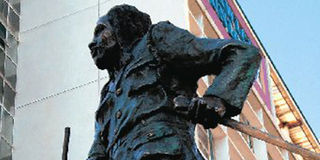Monuments that said the British were in control

Dedan Kimathi statue. Monuments are historical set pieces that are designed to give meaning to the landscape as a symbol of resistance, power, and dominance. PHOTO/FILE
What you need to know:
- The Delamere statue outside Stanley Hotel was removed on November 6, 1963, a few weeks before independence. It had been erected in 1939 to symbolise the creation of a British settler identity.
- That psychological imperative depends on a myriad factors, chief among them being whether the new nation understands the intended meaning of the existing monuments. For example, the Statue of Queen Victoria is often mistaken for that of the Virgin Mary.
Monuments are historical set pieces that are designed to give meaning to the landscape as a symbol of resistance, power, and dominance.
For the colonial government, monuments such as statues and street names were cultural marks of the colony’s place within the British Empire.
Most of them celebrated the monarchy, the ultimate symbol of British cultural and political order. Others celebrated the settlers and their new identity away from their homeland.
While some were removed in the adrenaline years before and immediately after independence, a few remain as constant reminders of the interconnectedness of time.
The three main royal monuments in colonial Nairobi were The Queen Victoria statue, the King George V statue (1945) and the King George VI memorial fountain (1957). Of these, only the Queen Victoria statue remains, situated within the Jevanjee Gardens.
Unveiled in 1906 by the Duke of Connaught, the monument is a stark reminder of the time Kenya was a mere colony. The monument was repaired in 1958 after vandals wrecked it, most likely as a direct assault on Britain’s soft power in the colony.
It is still in remarkably good condition, albeit almost forgotten in the public park. It survived the purge owing to its miniature size and the fact that it adds to the aesthetics of the public park.
The King George V statue was located at the junction of Queensway Road and Princess Elizabeth Way a symbolic meeting of the royal family.
It was designed and built by Gilbert Ledward in commemoration of King George V, Queen Victoria’s grandson and the current Queen Elizabeth II’s grandfather. He had succeeded his father, King Edward VII, in 1910 and ruled until 1936.
The statue that once stood in front of the Nairobi Law Courts celebrated his Silver Jubilee.
The imposing King George V statue was removed in May 1964, leaving its tall pedestal in place for several more years. King George VI, the father of the current British monarch, was the second son of King George V and only inherited the throne after the abdication of his elder brother.
To celebrate his reign, the colonial government built an elaborate fountain with a bronze plaque bearing his portrait. The city authorities also removed it as the new nation sought to erase the most imposing statues.
The Delamere statue outside Stanley Hotel was removed on November 6, 1963, a few weeks before independence. It had been erected in 1939 to symbolise the creation of a British settler identity.
The debate on its proper disposal makes for an interesting view of the psychological pressures of independence.
One suggestion was to melt down the bronze statue and refashion it in the image of Kenya’s first president, Jomo Kenyatta.
The psychological basis for this was most likely more symbolic than austere. The ideas were, however, shelved and the monument transferred first to the Museums and then to the Soysambu Ranch, where the founding colonial settler now sits, binoculars in hand, overlooking Lake Elementaita.
The Ashgate Research Companion to Heritage and Identity portends that “…the destruction, removal, or alteration of colonial heritage, and if possible its replacement with symbols of the new socio-political order, appear not only desirable but indeed a psychological imperative”.
That psychological imperative depends on a myriad factors, chief among them being whether the new nation understands the intended meaning of the existing monuments. For example, the Statue of Queen Victoria is often mistaken for that of the Virgin Mary.
While the statue has survived due to other reasons, the mistaken interpretation has somewhat contributed to its integration within independent Kenya.
The Galton-Fenzi monument at Nairobi’s GPO honours the man who founded the Automobile Association of Kenya in 1919. Erected in 1939, it also notes his different endeavours as a pioneer of the efforts to establish and map out a road network in Kenya.
The other remaining statue is the Hamilton Fountain. It is better known as the “Naked Boy” because it features a naked boy holding a fish.
It was commissioned in honour of the lawyer Alexander George Hamilton, who died in 1937. The statue is placed in a picturesque fountain outside the Nairobi Law Courts.
Such statues survived because their social significance was not as profound as that of the most prominent political and cultural symbols, the monarchy, and the Third Baron Delamere.
Ironically, the monuments that replaced those of the colonial era, such as the ones of Kenyatta erected in 1963 and 1973, were designed and built in England. Kenya lacked the expertise and resources to make them.




